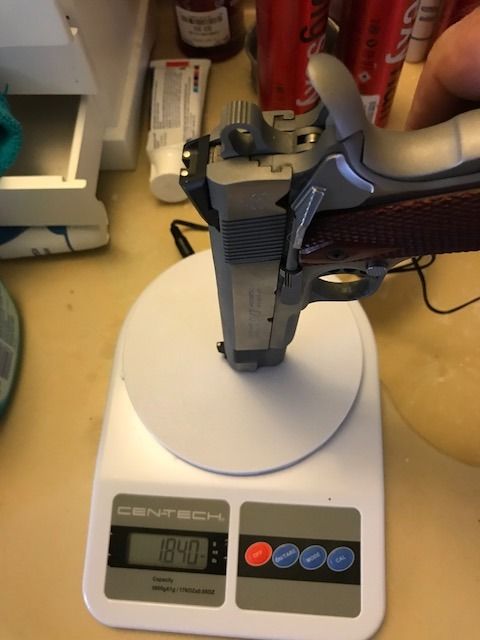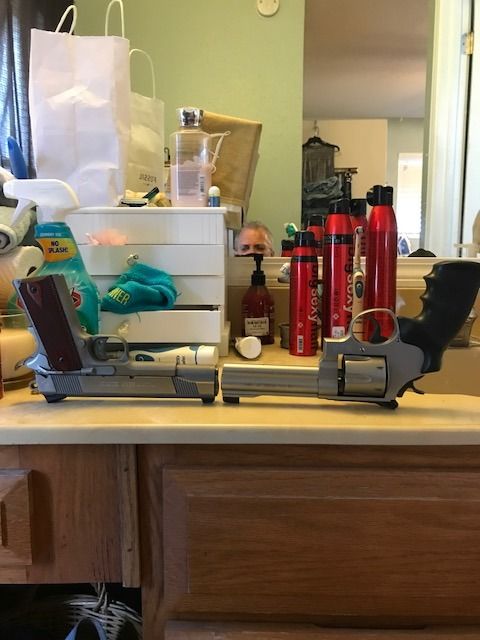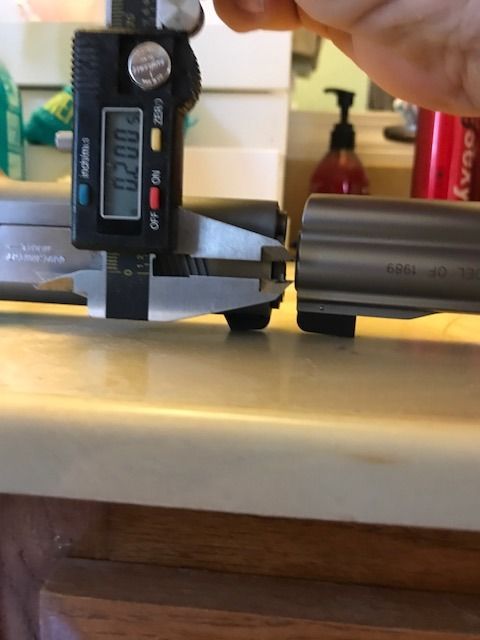Walt Sherrill said:
My assumptions:
- How far the bullet moves in the barrel is related and proportional to how far the slide and barrel move and how far a recoil spring or hammer springs are compressed.
I'm going to call the barrel and slide the "upper" since calling it barrel/slide can get confusing when also using the "/" symbol for division.
The distance the bullet moves in the barrel is NOT proportional to how far the upper moves. They are obviously related, but the squared time term in the acceleration component of the force equation (equal forces bullet and upper) is going to make it nonlinear, thus non-proportional if your bullets have different velocities. The bullet and upper will have equal momentum but different accelerations for different bullets. This is because the different masses and velocities of the bullets require different forces (thus different accelerations and positions) to achieve equal momentum to optimize the function of the gun. It will probably be as nasty getting there as the explanation above, but we will try anyway.
Summation is in the next couple of paragraphs if you want to skip everything between the "Physics Stuff" and "End of Physics Stuff" below:
As the bullet leaves the muzzle and the recoil force ends, the slide is moving at 13.7 FPS
An 8% lighter bullet moves the upper 13% less in 7% less time. When the recoil force from firing a 185 grain bullet at 1050 FPS ends, the upper has moved .061”. The recoil spring and hammer spring are compressed 13% less than when firing a 200 grain bullet at 975 FPS where the upper has moved .070”.
A 13% lighter bullet moves the upper 15% less in 15% less time. When the recoil force from firing a 200 grain bullet at 975 FPS ends, the upper has moved .070”. The recoil spring and hammer spring are compressed 15% less than when firing a 230 grain bullet at 830 FPS where the upper has moved .081”.
A 20% lighter bullet moves the upper 26% less in 21% less time. . When the recoil force from firing a 185 grain bullet at 1050 FPS ends, the upper has moved .061”. The recoil spring and hammer spring are compressed 26% less than when firing a 230 grain bullet at 830 FPS where the upper has moved .081”.
Hopefully it’s obvious from above that the upper position is NOT proportional to bullet position. The upper can be positioned at .061”, .070”, or .082” with different weight & velocity bullets located at the exact same position (the muzzle). If upper position was proportional to bullet position, at a constant bullet position (5"), the upper position would be constant.
This means that when the bullet leaves the muzzle the recoil and hammer spring are compressed different amounts by the different bullets.
The force of compressing the recoil and hammer springs is directly transmitted to the frame of the firearm, thus to the shooter’s hand and wrist.
Barrel rise is caused by the pivoting action of the firearm about the shooter’s wrist. This pivoting action is caused by the torqueing of the firearm. Since Torque = Force * Distance, and the distance from the shooter’s wrist to the bore axis remains constant, hopefully it is obvious that less force = less torque = less pivoting of the wrist while the bullet is in the barrel.
The difference in compressing the hammer and recoil spring .082” (230 grain), .070” (200 grain), and .061” (185 grain) is obviously not going to cause huge differences in the recoil forces transmitted to the shooters hand while the bullet is in the barrel. Should be easy enough to measure this with a 1911 and a scale if anyone cares. I have a hard time imagining ANY handheld shooting test using ANY amount of shots being precise enough to provide any meaningful data with the forces being so close together.
Walt Sherrill said:
- The components listed above act as part of a fixed relationship until the bullet leaves the barrel -- when the barrel and slide go to their different stops on the frame.
It's a mechanical linkage - the physical relationships are definitely fixed.
Walt Sherrill said:
Different weight bullets moving at different speeds will change the time it takes for the different components of this fixed relationship to go through their related motions, but not how the parts move in their relationships to each other.
True statement. Faster, lighter bullets will exit the upper at an earlier point in the upper's travel than heavier, slower bullets. In all cases all bullets exit the upper and recoil forces have ended far before the barrel unlocks. The upper will still continue rearward due to it's momentum and physical linkages.
Walt Sherrill said:
And there was a general consistency in the results cited by others who did their own tests. I showed an image of my results. Did we all make the same errors? Or were we simply shooting our handguns at targets so close that the differences aren't significant?
Push the barrel of your 1911 against a scale and figure out how much difference in force is required to move a 1911 upper .082", .070", and .061" out of battery and we'll figure out how much difference in torque your wrist is reacting among the various weight bullets and how much the muzzle might rise while the bullet is in the barrel. My guess is that your shooting is not precise enough to measure the difference, thus my earlier comment on fixed rests and thousands of rounds.
Physics stuff
Upper momentum = bullet momentum.
Different bullet/velocity combinations can have the same momentum, but since the bullets have different velocities, how far they move in the barrel is NOT related to how far the slide and barrel move.
For example, Speer makes FMJ's in 185, 200 & 230 grains:
Momentum = mass(bullet) * velocity(bullet)
Momentum(230) = (230/7000)/32.2 * 830 = .85 sl-ft/s
Momentum(200) = (200/7000)/32.2 * 975 = .87 sl-ft/s
Momentum(185) = (185/7000)/32.2 * 1050 = .86 sl-ft/s
Notice the essentially identical momentum of each combination.
If you go back to the example with the 230 grain bullet in Post 22 where we calculated the forces, you'll find that the 2 pound slide/barrel had a velocity of 13.7 ft/s. Want to bet what it's momentum will be?
Momentum(slide/barrel(Post 22) = (2/32.2) * 13.7 = .85 sl-ft/s
Notice how the momentum delivered to the slide/barrel is identical (I'm only carrying two decimal places, feel free to go out as far as you feel necessary in the calculations if you desire more resolution) for all three bullet/velocity combos from Speer, which means the slide/barrel momentum will be identical. No need to change recoil springs or do any tuning when shooting different weights of their ammo.
Since the slide/barrel mass is identical, then the slide/barrel velocities will be identical among the three bullet weights.
However, since the lighter bullets are accelerating faster, they spend a shorter amount of time in the barrel.
Assuming constant acceleration and a time in the barrel of .001 seconds from the 830 FPS, 230 grain bullet example in Post #22, then:
200 grains at 975 FPS = 830/975 * .001 = .00085 seconds in the barrel.
185 grains at 1050 FPS = 830/1050 = .00079 seconds in the barrel.
The lighter, faster bullets spend proportionately less time in the barrel. But since the upper momentum is identical, and the upper mass is identical, that means the upper velocity must be the same in each case.
However, to accelerate the upper to the same velocity but in a shorter time, that means that the acceleration of the upper must be greater. Since we cleverly know that Force = Mass * Acceleration, and the mass of the upper is constant, then greater Acceleration = greater Force.
In a nutshell, the lighter bullets are putting greater force on the slide for a shorter time to achieve momentum identical to the heavier bullet.
We also know that Power = Force * Distance. To achieve greater force in an equal distance (barrel length) would mean that the lighter bullets would need more Power. Since our power source is gunpowder, if you are a reloader it should now be obvious why lighter bullets require more gunpowder than heavier bullets. The lighter bullets have to accelerate the upper to a velocity equal to that achieved by the heavier bullets but in a shorter time.
From the example in Post #22, we calculated the force delivered to the upper by the 230 grain bullet at 830 FPS to be 851 pounds to accelerate the slide to 13.7 FPS in .001 seconds.
Since the 200 grainer at 975 FPS is only in the barrel for .00085 seconds, and we know the upper velocity must be 13.7 FPS since the upper momentum is the same and the upper mass is the same, we can calculate the slide position using the known time and velocity:
Xf = Xi + Vi x T + (A x T**2) / 2
Xf = 0 + 0 x .00085 + (13695 x .00085**2) / 2
Xf = .0057973 feet = .070 inches
The 185 grainer at 1050 leaves the slide after it moves
Xf = 0 + 0 x .00079 + (13695 x .00079**2) / 2
Xf = .0050635 feet = .061 inches
Since we know the mass and velocity of the upper and the distance and time in which it was accelerated to that velocity, we can figure out how much force was exerted on the upper:
We know the 230 grain exerts 851 pounds of force on the slide for .001 second from Post #22.
For the 200 grain:
Velocity = Acceleration * Time
13.7 = A * 0.00085
A = 13.7/0.00085 = 16,118 ft/s^2
Force = Mass * Acceleration = 2/32.2 * 16,118 = 1001 pounds
For the 185 grain:
Velocity = Acceleration * Time
13.7 = A * 0.00079
A = 13.7/0.00079 = 17,342 ft/s^2
Force = Mass * Acceleration = 2/32.2 * 17,342 = 1077 pounds
Notice how the lighter bullets require more force? That force comes from the gunpowder. If you reload, notice the difference in powder charges on light vs heavy bullets.
End result:
185 grain bullet moves 5 inches while upper moves .061" in .00079 seconds as a result of the 1077 pounds applied for the .00079 seconds that the bullet is in the barrel.
200 grain bullet moves 5 inches while upper moves .070" in .00085 seconds as a result of 1001 pounds of force applied for the .00085 seconds that the bullet is in the barrel.
230 grain bullet moves 5 inches while upper moves .082" in .001 seconds as a result of 851 pounds of force applied for the .001 seconds that the bullet is in the barrel.
185/200 = 8% lighter bullet .061/.070 = 13% less slide movement .00079/.00085 = 7% less time in barrel
200/230 = 13% lighter bullet .070/.082 = 15% less slide movement .00085/.001 = 15% less time in barrel
185/230 = 20% lighter bullet .061/.082 = 26% less slide movement .00079/.001 = 21% less time in barrel
End of Physics Stuff





